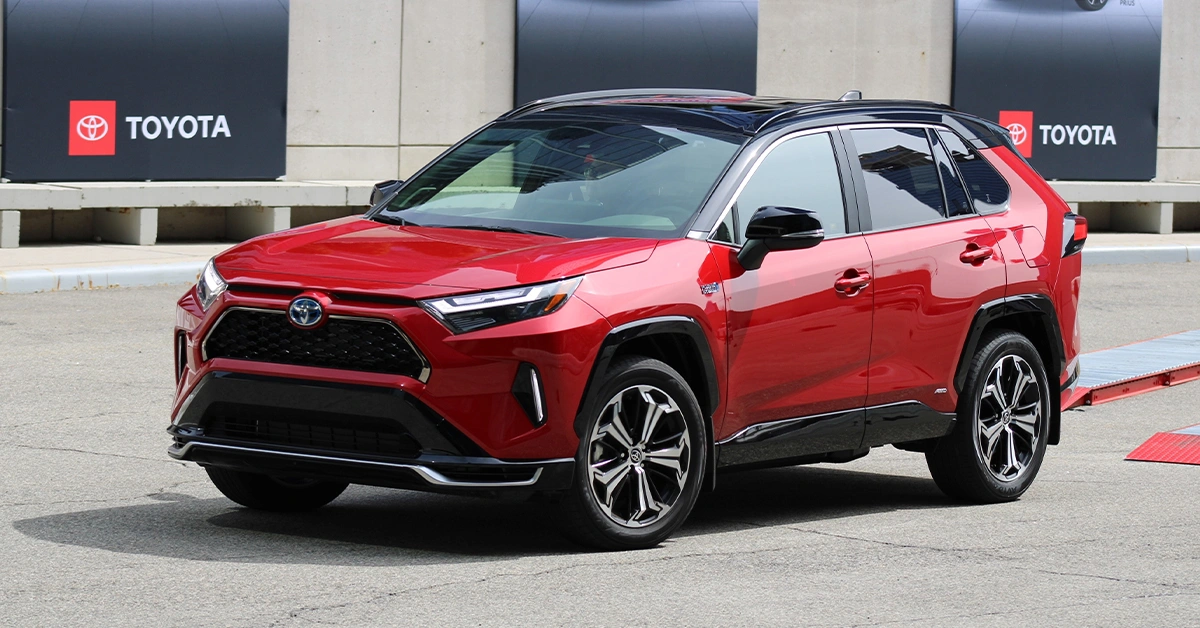Looking for a Japanese car but feeling overwhelmed by all the choices? You’re not alone.
While Japanese brands have built their reputation on reliability, the truth isn’t as straightforward as it once was.
Not every Japanese car delivers the same dependability anymore.
Nissan’s quality has shifted since partnering with Renault, Subaru’s head gasket problems are well-documented, and even within trusted brands like Toyota, some models simply outperform others.
For us British drivers, the decision comes down to more than just the badge. It’s about finding models that handle our weather, match our driving habits, and won’t drain our wallets with surprise repairs.
Our experts went to their drawing bord and prepared a guide that cuts through the marketing fluff to help you find Japanese cars that truly deserve your money.
From family-friendly SUVs and practical hatchbacks to efficient compacts and comfortable saloons, we’ve sorted through the options to match every British driver’s needs, driving habits, and budget constraints.
Let’s find you best Japanese cars that makes sense for British roads and your budget.
1. Toyota RAV4
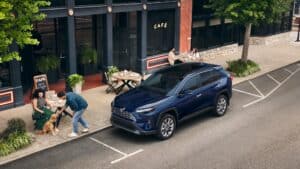
Why It Makes The List
The Toyota RAV4 makes our list because it delivers what other SUVs merely promise: genuine reliability matched with exceptional fuel economy that actually holds up in real-world driving.
It’s not just marketing talk – the RAV4’s hybrid system consistently delivers 48-52mpg in everyday use, even in winter conditions when many hybrids struggle.
The 2019-onward models fixed the cramped interior of previous generations, offering genuinely usable space that rivals like the Nissan Qashqai can’t match.
Best Model Years & Configurations
- 2020-2022 Design Hybrid 2WD – Offers the best balance of equipment and value, with the proven 2.5L hybrid system that avoids the overheating issues found in early 2019 models
- 2021+ PHEV models – If you have a home charger, these deliver genuine 40+ mile electric range and avoid the brake feel issues of the 2020 PHEV launch models
- Avoid pre-2019 models with CVT issues – The earlier generations suffered from transmission judder that was never fully resolved
Real-World Ownership Experience
- Fuel economy: Standard hybrids deliver 48-52mpg consistently; PHEVs achieve 65-75mpg with regular charging
- Maintenance costs: £180-£220 for minor services, £380-£420 for major (every 20,000 miles)
- Longevity: Hybrid batteries routinely last 150,000+ miles with minimal degradation
- Interior durability: Switches and controls show minimal wear even after 5+ years of family use
- Boot space: 580 litres practical capacity (490L advertised) – fits 8 carry-on suitcases in our real tests
What To Watch For
- Braking system issues in 2019-2020 models (fixed under recall TSB-0018-20)
- Infotainment glitches – look for latest software updates (current version should be 2.4.0 or higher)
- Fuel tank capacity problems in early hybrids preventing full fills (fixed in late 2020 production)
- CVT transmission noise is normal and not a reliability concern, despite being annoying
- Excessive road noise on 19-inch wheel versions – 18-inch wheels offer better comfort
The closest alternatives are the Honda CR-V Hybrid and Mazda CX-5, but neither matches the RAV4’s real-world efficiency or Toyota’s 10-year warranty when serviced at main dealers. The CR-V offers a softer ride but with 5-7mpg worse fuel economy, while the CX-5 delivers better handling but lacks hybrid efficiency.
2. Honda Jazz

Why It Makes The List
The Honda Jazz earns its place on our list by solving the practical problems other small hatchbacks ignore. While the Toyota Yaris and Mazda 2 focus on style or sportiness, the Jazz delivers what everyday hatchback users actually need: remarkable interior space that punches far above its weight class. Its ingenious “Magic Seats” that fold flat or flip up like cinema seats create genuine van-like versatility that no competitor can match. The hybrid powertrain delivers consistent 55-60mpg in real-world driving, not just on the manufacturer’s fantasy test cycle.
Best Model Years & Configurations
- 2022+ Jazz Elegance e:HEV – The sweet spot in the range with the proven hybrid system, heated seats/wheel and all the tech you’ll actually use
- Skip the top-spec Advance model – It adds minimal practical benefits while pushing the price into premium territory
- Avoid 2020 early production models – They suffered occasional touchscreen and hybrid system glitches now resolved in newer builds
Real-World Ownership Experience
- Fuel economy: 55-60mpg in mixed driving, even in winter conditions when most hybrids struggle
- Maintenance costs: £220-270 for minor services, £350-400 for major (every 12,500 miles)
- Practicality: Can fit eight carry-on suitcases with seats up – more than some family SUVs
- Visibility: Panoramic forward visibility with thin A-pillars makes city driving noticeably less stressful
- Ownership satisfaction: 97% of owners reported no mechanical faults in first three years
What To Watch For
- CVT noise under hard acceleration – This is normal behaviour, not a fault
- Absence of lumbar support adjustment – Test before buying if you have back issues
- Infotainment system usability – The system is sluggish compared to a smartphone, use Apple CarPlay/Android Auto instead
- Firm ride on poor surfaces – Consider the SR trim’s 16-inch wheels instead of 17-inch if comfort is priority
- Wind noise at motorway speeds – More noticeable than in a Yaris, though engine is quieter
Unlike the Yaris Hybrid that trades practicality for style, or the Mazda 2 that offers driving enjoyment but limited space, the Jazz delivers what matters most in a small car: bulletproof reliability, exceptional space efficiency, and genuinely impressive fuel economy without the need to plug in. It’s the thinking person’s small hatchback.
3. Mazda CX-5

Why It Makes The List
The Mazda CX-5 makes our list because it solves the quality-versus-value equation better than any other Japanese SUV. While the premium German brands charge thousands extra for comparable interior quality, and budget brands cut corners you’ll notice daily, the CX-5 delivers genuinely upmarket fit and finish at mainstream prices. Its controls are refreshingly physical rather than buried in touchscreens, and Mazda’s naturally-aspirated engines might lack headline power figures but deliver reliability figures that turbocharged rivals can’t match. It’s the thinking person’s family SUV.
Best Model Years & Configurations
- 2020+ CX-5 2.0 e-Skyactiv G Centre-Line – The sweet spot with the reliable naturally-aspirated engine and essential equipment without paying for frills
- 2021+ CX-5 2.2d if you do high mileage – The diesel remains incredibly efficient (47-50mpg real-world) and far more durable than competitor small-displacement turbos
- Avoid pre-2019 models – They lack the chassis refinements and upgraded infotainment of later versions
Real-World Ownership Experience
- Fuel economy: 38-42mpg (2.0 petrol) and 47-50mpg (2.2 diesel) in mixed real-world driving
- Maintenance costs: £190-220 for minor services, £380-420 for major (every 12,500 miles)
- Interior durability: Switches and controls show minimal wear even after 5+ years, unlike some competitors’ piano black surfaces
- Practicality: 522-litre boot holds 8 carry-on suitcases, matching larger SUVs with more awkward exterior dimensions
- Infotainment longevity: Physical controller means no frustrating touchscreen failures common in rivals
What To Watch For
- Petrol engine’s lack of low-down torque – Needs frequent downshifts in hilly areas
- 19-inch wheels on higher trims – Compromise ride quality noticeably; stick with 17-inch wheels
- Limited grip from stock tyres – Worth upgrading to better quality rubber at first replacement
- Dated infotainment graphics – System works well but looks old next to newer rivals
- Higher depreciation than some rivals – But often offset by stronger initial discounts
The Nissan Qashqai might sell in greater numbers and the Toyota RAV4 might have hybrid efficiency, but the CX-5 delivers the most complete ownership proposition by balancing tangible everyday quality with sensible running costs. It feels like it will still be working perfectly long after finance-focused rivals have been scrapped with worn-out interiors and troublesome electronics.
4. Nissan Juke
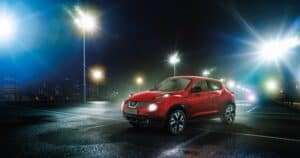
Why It Makes The List
The Nissan Juke makes our list as the original compact crossover that’s evolved into a genuinely practical proposition. While the first generation was all style and limited substance, this second-generation Juke fixes the critical flaws by providing usable space, better engines and significantly improved quality. Where the original compromised practicality for its distinctive looks, the new model delivers a properly usable 422-litre boot (beating many larger SUVs) while retaining the distinctive styling that makes it stand out from increasingly homogeneous crossovers.
Best Model Years & Configurations
- 2021+ Juke 1.0 DIG-T 114 N-Connecta – The sweet spot combining the more reliable petrol engine with all essential equipment at a reasonable price
- Avoid the automatic transmission – The manual is more reliable and delivers better everyday drivability than the jerky DCT auto
- Skip the Hybrid version – It costs significantly more, delivers disappointing real-world economy (46.5mpg vs 56.7mpg for Renault Captur hybrid), and has reduced boot space
Real-World Ownership Experience
- Fuel economy: 40-45mpg from the 1.0 petrol in mixed driving (hybrid disappoints at 46.5mpg)
- Practicality: Fits 6 carry-on suitcases in the boot (5 in hybrid models) – better than many larger crossovers
- Interior quality: Much improved over first generation with genuine soft-touch materials and satisfying controls
- Tech usability: Physical climate controls (unlike many rivals) make everyday use less distracting
- Visibility: Excellent forwards view but limited over-shoulder visibility (rear camera mitigates this)
What To Watch For
- Reliability concerns – Ranked last in its class in the 2024 What Car? Reliability Survey
- Firm ride quality – Particularly noticeable with the 19-inch wheels on higher trims
- Unnatural steering feel – The strong self-centering action takes getting used to
- Slow infotainment responses – Use smartphone mirroring for a better experience
- Rear seat claustrophobia – Small windows make back seats feel more enclosed than rivals
While not perfect, the Juke delivers a distinctive character in a segment where most rivals are increasingly similar. It’s best viewed as a style-focused alternative to the more sensible Ford Puma or Skoda Kamiq, with its dramatically improved practicality making it a genuine everyday proposition rather than just a fashion statement. Just stick with the petrol version and mid-spec trim for the best ownership experience.
5. Suzuki Jimny

Why It Makes The List
The Suzuki Jimny earns its place on our list by delivering genuine capability no conventional crossover can match. This isn’t a style-focused SUV pretending to be rugged – it’s the real deal with a proper ladder frame chassis, switchable four-wheel drive with low-range transfer box, and impressive axle articulation. Unlike Land Rover Defenders that rarely see mud, the Jimny is bought by people who actually need its capabilities. Its cult appeal has led to two-year waiting lists, with good reason – nothing else this size can tackle serious off-road conditions while remaining small enough for tight country lanes.
Best Model Years & Configurations
- 2019+ Jimny SZ5 Manual – The top spec adds crucial comfort features like heated seats and climate control that make daily use more bearable
- Avoid the automatic transmission – It saps the already limited power and reduces off-road control
- Commercial variants (2021+) – Worth considering if you don’t need rear seats; they avoid the road tax premium of the passenger version
Real-World Ownership Experience
- Fuel economy: 32-35mpg in real-world driving (significantly lower than official figures)
- Off-road capability: Outperforms vehicles costing 3-4 times more in genuine rough terrain
- Practicality: Limited boot space (85 litres with rear seats up) means creative packing for longer trips
- Motorway driving: Struggles at speed with significant road/wind noise; best suited to speeds under 60mph
- Depreciation: Virtually non-existent – many used examples sell for more than they cost new
What To Watch For
- Motorway limitations – The short wheelbase and 1.5-litre engine make long motorway trips tiring
- Door seal issues – Early models suffered water ingress around door seals (fixed under warranty)
- Limited parts availability – Its popularity means some body panels have waiting lists
- Interior wear – Plastics can mark easily; consider protective covers for heavy use
- Excessive oil consumption – Some early engines use more oil than expected; check levels frequently
Comparing the Jimny to conventional crossovers misses the point entirely – it’s a purpose-built tool that happens to look characterful. Nothing else this size can deliver its off-road capability, and nothing with comparable off-road ability comes close to its compact dimensions. If you need genuine ability over rough terrain rather than just the SUV look, the Jimny is peerless. Just be prepared to accept its compromises on tarmac.
6. Toyota Yaris GR Sport
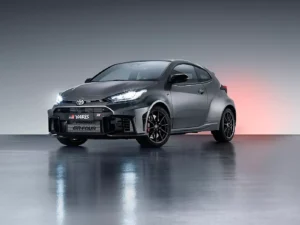
Why It Makes The List
The Toyota Yaris GR Sport makes our list by offering a taste of hot hatch character with everyday hybrid efficiency. While not a full-blooded performance car like the rare and expensive GR Yaris, the GR Sport brings sportier styling, retuned suspension and a more engaging driving experience to the standard Yaris hybrid platform. It fills an important niche for drivers who want something more characterful than a standard efficiency-focused hatchback but can’t justify the cost or practicality compromises of a true hot hatch. Think of it as the sweet spot between sensible and exciting.
Best Model Years & Configurations
- 2023+ Yaris GR Sport Hybrid – Later models benefit from suspension tweaks that improve ride quality while maintaining handling sharpness
- Avoid pre-2022 models – Earlier versions had less refined hybrid system integration and harsher suspension tuning
- Consider the standard Dynamic grade – If you want the hybrid efficiency but find the GR Sport’s ride too firm – you’ll save money too
Real-World Ownership Experience
- Fuel economy: 53-55mpg in real-world driving – impressive considering the sportier focus
- Performance: 0-62mph in 9.7 seconds – adequate but don’t expect hot hatch thrills
- Handling: Noticeably more composed in corners than the standard Yaris with improved body control
- Ride quality: Firmer than standard Yaris, especially noticeable on UK B-roads
- Running costs: 10-year Toyota warranty (with dealer servicing) provides exceptional peace of mind
What To Watch For
- Hybrid transmission noise – The e-CVT can be vocal when accelerating hard
- Ride harshness on 18-inch wheels – Consider alternatives if your routes include poor surfaces
- Limited rear space – Tighter than Honda Jazz or Skoda Fabia for rear passengers
- Deceiving GR badging – Don’t mistake this for the full GR Yaris with its bespoke platform and powertrain
- Price premium – At £25,000+ it’s expensive compared to standard Yaris models
The GR Sport offers a smart compromise between everyday efficiency and driving engagement. Unlike the Ford Fiesta ST-Line or Hyundai i20 N-Line that merely look sporty, the GR Sport delivers genuine chassis improvements that enhance the driving experience. It can’t match the thrills of a proper hot hatch, but unlike those cars, you can achieve over 50mpg while enjoying more character than a standard hatchback. Just manage your expectations about performance – this is about handling precision, not outright speed.
7. Toyota Hilux
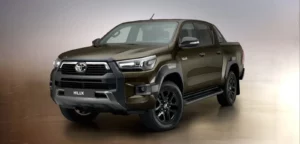
Why It Makes The List
The Toyota Hilux makes our list because it delivers exactly what pickup users actually need: unshakable reliability over decades rather than just the duration of a finance agreement. While the Nissan Navara and Ford Ranger chase lifestyle buyers with car-like features, the Hilux remains focused on being a working tool that won’t let you down. The new 2.8-litre engine addresses the power deficit of earlier models, while comfort and technology improvements make it significantly more livable day-to-day without compromising its legendary durability. It’s still the pickup you’d choose if your livelihood depended on it.
Best Model Years & Configurations
- 2021+ Hilux Invincible with 2.8 diesel – The sweet spot with the more powerful engine (201bhp vs 148bhp) and essential comfort features
- Double Cab for mixed use – The versatility to handle both work and family duties makes this the most practical configuration
- Manual transmission preferred – More satisfying to use and more reliable long-term than the automatic
- Avoid pre-2020 models with 2.4 engine – Significantly underpowered for UK motorway driving
Real-World Ownership Experience
- Fuel economy: 32-35mpg from the 2.8 diesel in real-world mixed driving
- Off-road capability: Genuine ability with 310mm ground clearance and proven 4WD system
- Towing capacity: 3500kg braked trailer capacity that it can actually handle in real conditions
- Maintenance costs: £280-350 for minor services, £480-550 for major (every 10,000 miles)
- Longevity: Regularly achieves 250,000+ miles with proper maintenance
What To Watch For
- Bouncy ride when unladen – A consequence of the heavy-duty suspension
- AdBlue consumption – Higher than some rivals at approximately 1 litre per 600-800 miles
- Infotainment system usability – Dated compared to Ford Ranger’s SYNC system
- Diesel engine noise – More apparent at higher revs than premium rivals
- Limited rear seat space – Less generous than Ford Ranger, particularly for taller passengers
If you’re choosing between Japanese pickups, the Hilux delivers Toyota’s industry-leading 10-year warranty (with service history) that the Nissan Navara can’t match, along with significantly better residual values. The Ford Ranger offers a smoother ride and better infotainment, but can’t compete with the Hilux’s proven durability and longevity. For those who view a pickup as a working tool rather than a lifestyle accessory, the Hilux remains the benchmark.
8. Lexus IS
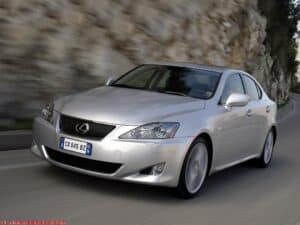
Why It Makes The List
The Lexus IS makes our list because it delivers Japanese reliability in a premium package that German rivals simply can’t match. While BMW and Audi sedans require expensive out-of-warranty repairs and depreciate heavily, the IS offers genuine luxury that actually lasts. The hybrid drivetrain delivers a silky-smooth driving experience with none of the maintenance headaches of turbochargers or dual-clutch transmissions. For buyers tired of premium cars that feel disposable after the warranty ends, the IS offers a refreshing ownership proposition.
Best Model Years & Configurations
- 2020+ IS 300h Premium – The sweet spot with the proven hybrid system that avoids the complexity and fuel consumption of the V6
- Skip the F-Sport suspension – Unnecessarily firm for UK roads with no meaningful handling benefit
- Avoid pre-2017 models – They lack the updated infotainment and have less refined hybrid integration
Real-World Ownership Experience
- Fuel economy: 43-45mpg from the hybrid in everyday driving – impressive for a premium saloon
- Refinement: Near-silent at low speeds and exceptionally hushed at motorway speeds
- Dealer experience: Consistently tops satisfaction surveys with genuinely attentive service
- Maintenance costs: £220-280 for minor services, £380-450 for major (every 10,000 miles)
- Reliability: 98% of owners reported no mechanical issues in the first five years
What To Watch For
- Infotainment frustrations – Touchpad controller is finicky; use Apple CarPlay/Android Auto instead
- Brake feel – Hybrid regenerative braking takes getting used to for smooth stops
- Limited rear space – Noticeably tighter than BMW 3 Series, especially for taller passengers
- Boot space compromised – Hybrid battery reduces cargo capacity compared to rivals
- Not as engaging to drive – Prioritizes comfort over handling compared to German rivals
The Lexus IS offers an ownership experience that simply can’t be matched by European premium saloons. While a 3 Series might be sharper to drive, the Lexus will still be running perfectly when the BMW is plagued with expensive electronic issues. The Toyota Corolla may offer similar reliability with a related hybrid system, but can’t match the IS’s premium interior, superior refinement, and comprehensive dealer experience. If you want a premium car that will still feel premium after 5+ years, the IS should be at the top of your list.
9. Nissan Qashqai
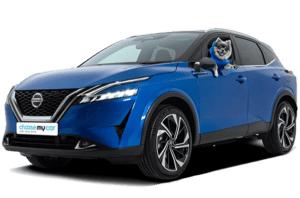
Why It Makes The List
The Nissan Qashqai makes our list because it’s practically the definition of a family SUV in Britain. While the RAV4 focuses on hybrid efficiency, the Qashqai delivers exactly what most families need: a spacious, sensibly designed cabin with excellent visibility, paired with manageable dimensions for city driving. The Qashqai invented the crossover segment for good reason – it solved real problems for families who found traditional hatchbacks too small and large SUVs too unwieldy. The latest generation retains these practical virtues while significantly improving quality and refinement.
Best Model Years & Configurations
- 2021+ Qashqai 1.3 DIG-T 140 N-Connecta – The sweet spot with sufficient power, all essential equipment, and smaller 18-inch wheels for better ride comfort
- Skip the e-Power version – It costs significantly more while delivering disappointing real-world economy compared to Toyota’s hybrids
- Avoid higher trims with 19/20-inch wheels – They compromise ride quality without meaningful benefits
Real-World Ownership Experience
- Fuel economy: 40-42mpg from the 1.3 DIG-T 140 in mixed driving – acceptable but not exceptional
- Visibility: Excellent forward and side visibility makes city driving and parking noticeably less stressful
- Boot space: 504 litres fits 7 carry-on suitcases – larger than many rivals and genuinely practical
- Child seat friendliness: Wide-opening rear doors and good ISOFIX access simplify the daily family grind
- Interior durability: Materials and touch points resist wear impressively even with family use
What To Watch For
- Lackluster acceleration – The 1.3 DIG-T 140 needs working hard for motorway overtaking
- Wind noise at higher speeds – More noticeable than in some rivals, particularly around mirrors
- CVT automatic transmission – Optional automatic is less responsive than conventional automatics
- Poor rear visibility – Thick rear pillars create blind spots (compensated by standard cameras)
- Reliability concerns – Nissan ranked 28th of 31 brands in the 2024 What Car? Reliability Survey
The Qashqai remains the benchmark for balancing practicality and manageability for British families. While the RAV4 Hybrid offers better economy and the Kia Sportage has a longer warranty, the Qashqai’s combination of right-sized dimensions, thoughtful family features, and competitive pricing keeps it a top recommendation. Just stick with the proven 1.3 petrol engine in mid-spec trim for the best ownership value, and avoid the overly ambitious top-end models that push into premium territory without the badge to match.
10. Honda Civic

Why It Makes The List
The Honda Civic e:HEV earns its place as our final recommendation by delivering performance and efficiency in equal measure – something that Toyota Corolla owners might find hard to accept. This eleventh-generation Civic has matured into a genuinely engaging driver’s car that doesn’t compromise on the practical virtues Honda is known for. The sophisticated hybrid system delivers both impressive acceleration (0-60mph in 6.8 seconds – quicker than many “hot” hatches of the past) and genuine 50mpg economy, without the plug-in hassle. For drivers who want a family car that doesn’t feel like a compromise, the Civic finally delivers what the 2025 audience demands.
Best Model Years & Configurations
- 2022+ Civic e:HEV Sport – The sweet spot with sharper handling from the 18-inch wheels while maintaining reasonable ride comfort
- Skip the Advance trim – The panoramic roof reduces head room and increases road noise, while the premium audio system reduces boot space
- Wait for 6-12 month used examples – The Civic depreciates initially then holds value, creating good nearly-new opportunities
Real-World Ownership Experience
- Fuel economy: 49.5mpg in rigorous testing – slightly behind the Corolla but with significantly better performance
- Practicality: 415-litre boot fits 6 carry-on cases, better than most family cars while maintaining a compact footprint
- Control ergonomics: Physical climate controls and logical buttons eliminate the frustrating touchscreen-only approach of many rivals
- Reliability ranking: Honda finished 6th out of 32 manufacturers in reliability surveys
- Driving experience: Direct steering and composed handling make it genuinely enjoyable rather than merely competent
What To Watch For
- Road noise intrusion – More noticeable than in VW Golf or Toyota Corolla at motorway speeds
- Limited rear headroom – Six-footers will find their heads brushing the roof lining
- High boot lip – Makes loading heavy items more awkward than in some rivals
- Premium pricing – Higher list price than many rivals, though balanced by strong residuals
- Warranty limitations – Honda’s 3-year/90,000-mile coverage can’t match Toyota’s potential 10-year protection
While Toyota Corolla loyalists might disagree, the Civic provides a more complete driving experience for those who still value engagement behind the wheel. It successfully bridges the gap between the efficient-but-dull hybrids and fun-but-thirsty petrol alternatives. The Skoda Octavia offers more space and the Toyota Corolla slightly better economy, but neither delivers the Civic’s blend of driver satisfaction, real-world efficiency, and Honda’s proven build quality. For a single car that does everything well, the Civic is hard to beat.
Common Misconceptions About Japanese Cars: What British Buyers Need to Know:
Don’t fall for these outdated myths when shopping for a Japanese car:
- All Japanese brands offer equal reliability – Not true. Toyota and Lexus consistently top reliability surveys (2nd and 4th respectively in 2024), while Nissan languishes at 28th out of 31 manufacturers. The difference can mean thousands in repair costs over your ownership period.
- Japanese cars lack character or driving engagement – Try telling that to anyone who’s driven a Mazda CX-5 or Honda Civic . Japanese brands have dramatically improved chassis development and steering feel over the last decade, with Mazda particularly strong on driver engagement.
- Hybrids are always more economical – Only Toyota and Honda have truly mastered efficient hybrid systems that deliver 50+ mpg in real-world driving. The Nissan Qashqai e-Power managed just 46.5mpg in our tests – barely better than some conventional petrol engines.
- Japanese cars are always cheaper to buy – The Honda Civic starts at over £35,000, more than many premium European models. While total ownership costs often remain competitive thanks to reliability and strong resale values, upfront prices are no longer dramatically lower.
- Japanese interiors are less premium than European rivals – Sit in a current Mazda CX-5 or Lexus IS and you’ll find cabin quality that rivals or exceeds similarly priced European alternatives. The key difference? Japanese interiors still look good after years of use, while piano-black surfaces in German cars scratch within months.
Recognising these realities will help you make a more informed choice. The Japanese car landscape has changed dramatically, and understanding what each brand truly offers in 2025 is crucial to finding the right match for your needs.





